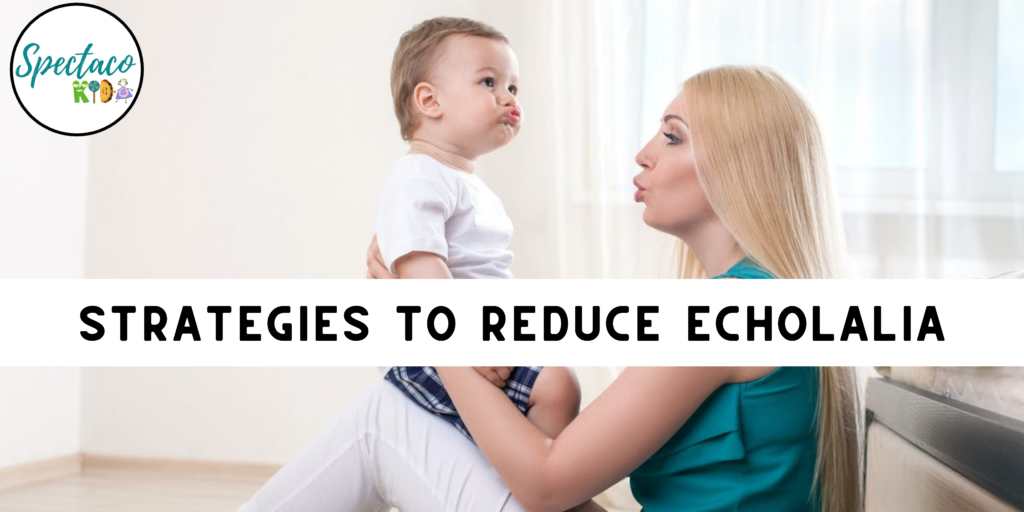What is Echolalia?
Echolalia refers to the repetition of certain words or phrases spoken by someone else, either after the words were said or later on.
Echolalia in autism
Echolalia is often associated as a function of Autism Spectrum Disorder (ASD). With an autistic child, echolalia may appear with more frequency versus children with standard developing language. While echolalia is most associated with ASD, it is not limited to it.
Individuals on the spectrum may use echolalia to cope with overwhelming sensory challenges or as a means of communication when it is too difficult for them to form their own words. They may also use it to interact and engage with others.
What are the signs of echolalia?
A person with echolalia may or may not be able to communicate normally or be able to understand others. Along with the repetition of phrases, other signs of echolalia may include frustration or annoyance during conversations, especially when asked questions.
Other signs include depression and muteness.
What is echolalia caused by?
Echolalia is a sign of developmental disability, communication disability or ASD in children over the age of three.
Adults with severe amnesia, head trauma and paralysis may also experience echolalia. In some cases, people experience echolalia only when they are distraught or worried. While others may experience it all the time, which may eventually cause them to be mute.
What are the types of echolalia?
- Immediate echolalia: Immediate echolalia refers to those words or phrases that are uttered immediately after they are heard. For example, a person may ask “Do you want an apple?” and the child would immediately respond “You want an apple”. This might be a way for the child to convey that he does want an apple. In another case, the child might repeat the question while he may be having time to process his real answer.
- Delayed echolalia: Delayed echolalia is where the individual memorizes a phrase, may it be from a movie or from an earlier conversation that he heard. In delayed echolalia, there is a distance between hearing and using the phrase. Sometimes a person may deliberately use an old phrase that he heard.
Functional and non-functional echolalia
Functional echolalia is intended to be interactional- a person is trying to communicate with another person and is using memorized phrases for a real purpose. For instance, a child may hear a line on TV such as “got cookies?” and later, when hungry, may say “got cookies?” in exactly the same tone and accent like the one they heard on TV. This is the child’s way of conveying that he really wants a cookie but is not using his own words.
Whereas, non-functional echolalia means that words being repeated do not mean anything. An individual may use non-functional echolalia for personal use or self-stimulation.
A child may be able to memorize an entire script of a cartoon episode, but he may have no idea who the characters are.
https://spectacokids.com/activities-to-help-improve-expressive-language/
Strategies to reduce echolalia:
Following are some strategies that can be used to reduce echolalia:
- Use simple words and phrases
- Prompt the correct response
- Use Visuals
- Do not ask questions
- Offer choices
- Model with a partner
- Avoid using names
- Stay patient
Use Simple Words and Phrases
When communicating with your child, try using simple words and sentences that he can comprehend. Do not repeat the sentence and wait for the child to process what you have said.
Prompt the Correct Response
Children tend to use echolalia when they do not know how to respond, or have trouble turning their thoughts into words. To help them, you can provide a script. For instance, ask your child “What is our dog’s name?” and reply “Bob.” Or you may ask your child “What is the color of the book” and reply “blue”. Repeat this until your child has learned the right script. Remember, this will only work for questions that always have the same answer.
Use Visuals
Using visual support is an important step of the strategy. Use a book that has pictures showing the language and have your child look directly at what is happening in the book. For example, while looking at the book, say, “This is an apple” and point it at the picture. You can even take his finger and point it at the apple and say “This is an apple”. Repeat until your child gives the correct response.
Do not ask questions
Avoid asking questions because when you ask questions, it gives your child the opportunity to repeat what you have said. Do not ask “Are you sleepy?” instead give the child the correct response like “I am tired, I am going to sleep”. This way your child will repeat what you have said.
Offer Choices
When talking with your child, do not ask them a question, instead give them a choice. Instead of asking them, try holding each item forward when offering the choices. For example, “Do you want _____ or _______?”. Be sure to model the names without the question tone at the end.
Model with a Partner
Another strategy to reduce echolalia is to model with a partner. Ask another person, he may be another student or a sibling your question and have them respond. For example, “Sara, what would you like to eat?” Sara will respond,” I want a banana.” Try this a few times in front of your child. Now ask your child what they want to eat.
Avoid Using Names
Avoid using your child’s name at the end of a sentence as they will start repeating it. When saying “Good Morning” say it without your child’s name. Or when you are praising your child, say “Good job!” instead of “Good job, Mike!”
Stay patient
Always be patient when your child is speaking no matter how long he takes. If your child does not feel pressured, then he will be more relaxed and will be able to use his words better. When you are done talking, allow your child to think before they form a response.
For more information, follow us on Instagram or visit our website!

